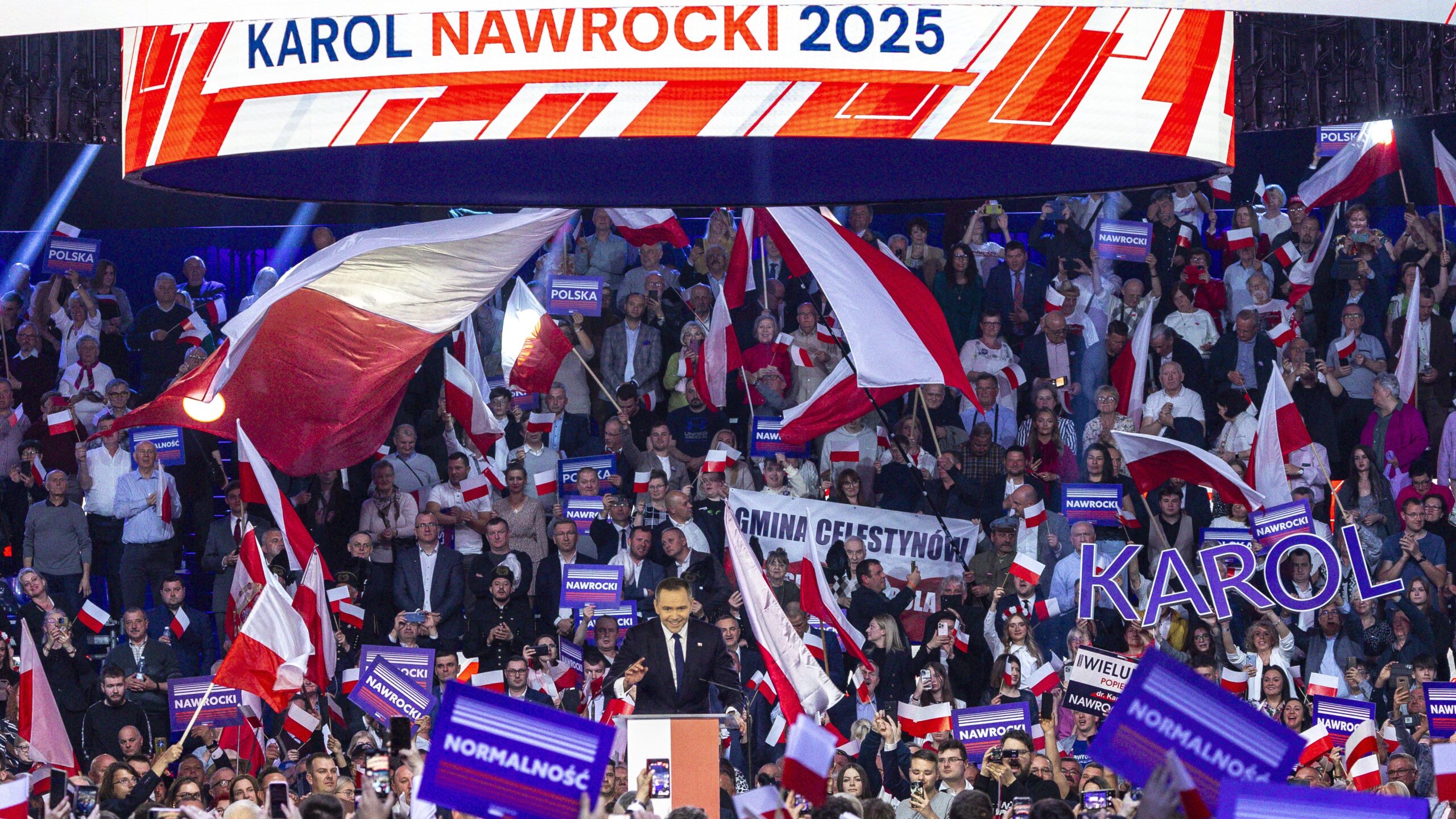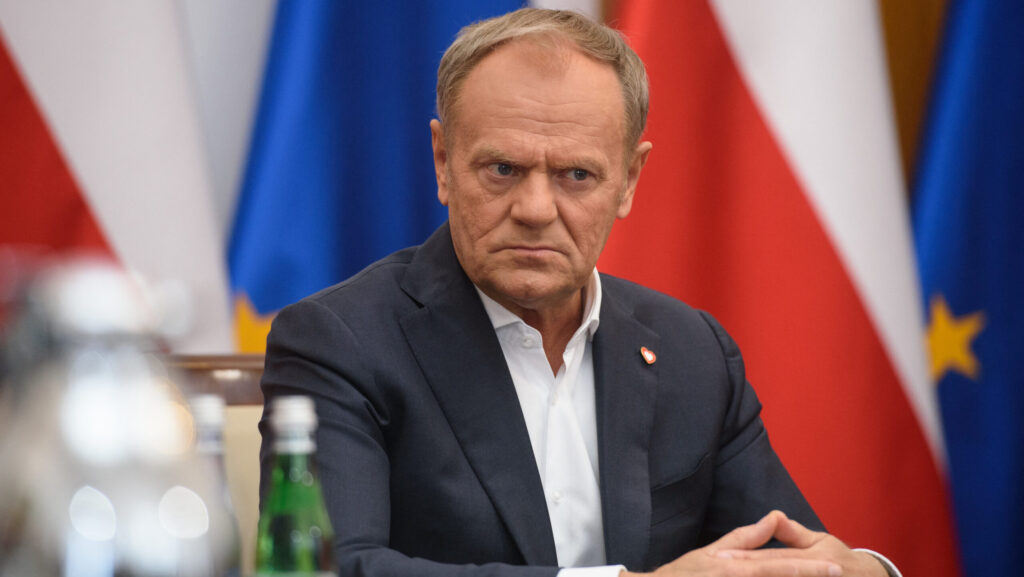On Sunday, outgoing Polish President Andrzej Duda surprised many observers when he appeared at Dr. Karol Nawrocki’s presidential convention in Łódź and endorsed the candidate.
Like the term-limited President Duda, Nawrocki is officially an independent political figure—as is traditional in Polish presidential politics—but is largely aligned with the opposition Law and Justice (PiS) party. Also like Duda five years ago, Nawrocki’s primary competitor is Warsaw Mayor Rafał Trzaskowski, a close ally of Prime Minister Donald Tusk. That year, Duda defeated Trzaskowski by a margin of 51.03 percent to 48.97 percent in the second round.
‘I will vote for Karol Nawrocki,’ asserted the current President.
The endorsement was relatively unexpected, as President Duda has sometimes had a tense relationship with PiS leader and former Prime Minister Jarosław Kaczyński. The President consistently enjoys higher favorability ratings than Kaczyński and other PiS figures and has maintained a nominally independent image in many quarters. Appearing to set aside any differences, Duda, Kaczyński, and Nawrocki appeared together on stage at the Łódź convention.
Also on Sunday, Mayor Trzaskowski held a rally in Poznań, a stronghold of his Civic Coalition (KO) party alliance. The rhetoric at both events was emblematic of the two main camps in fiercely divided Poland.
Trzaskowski accused Nawrocki of being a pawn of a scheming Kaczyński. ‘[I]t is important to say clearly that we do not agree to have another president who will be a puppet of President Kaczyński,’ asserted the Warsaw mayor. ‘[W]e do not agree to another Kaczyński puppet. We have had enough!’
‘The rhetoric at both events was emblematic of the two main camps in fiercely divided Poland’
Trzaskowski also reiterated the liberal platitudes that have been common in KO campaign rhetoric in recent years. ‘[T]ogether we have managed to build a strong Poland, a European Poland, a tolerant Poland, and no one will take that pride away from us,’ he proclaimed.
‘Well, Trzaskowski practically didn’t say a word about the “minor” detail of the country of which he is supposed to be President,’ responded journalist Dawid Wildstein. ‘Yes, there was virtually no mention of Poland.’
Over in Łódź, speakers also invoked a puppetry narrative. Nawrocki characterized the race as a contest between ‘the product of a political laboratory made up of briefs and polls, and installed for Donald Tusk,’ and ‘a man of flesh and blood, chosen by Poles and installed for Poles.’ He continued:
‘It matters that one of these candidates has never been and will never be held hostage by any political party. He will be held hostage by the Polish people. The other is held hostage by businessmen and developers in Poland, but also by Mr. Soros and German foundations. And we want freedom and sovereignty.’
On Sunday, flags maintained their usual symbolic roles in the two camps. The Nawrocki event in Łódź was a veritable celebration of Poland’s white-red colors, something that assumed additional significance since the event coincided with Divine Mercy Sunday, a Catholic feast day stemming from the life and works of the Polish St. Faustina, and in which the white-red colors represent ‘Blood and Water, which gushed forth from the Heart of Jesus, as a fount of mercy for us.’ At the Trzaskowski event, Polish flags were less evident, and they were interspersed with the blue-and-yellow of the European Union.
Migration, increasingly a key political topic, carried similar symbolism. As Poles of all political persuasions have consistently professed anti-migration views, the issue is a winner for the Nawrocki camp. Accordingly, Nawrocki asserted that the country needs to establish deportation centers, rather than migrant-integration centers. He was referring to the 49 migrant-integration centers the Tusk government has quietly established. The Trzaskowski camp and government allies have sought to limit discussion on this issue until after the election.
‘It matters that one of these candidates has never been and will never be held hostage by any political party. He will be held hostage by the Polish people’
Polls have remained rather consistent, with Trzaskowski established as the first-round (May 18) front-runner. Nonetheless, it is difficult to determine what this portends for the second round (June 1—unless a candidate achieves the statistically unlikely outcome of an outright majority in the first round).
The likely third-place finisher, according to polls, is Sławomir Mentzen of the populist right-wing Confederation (Konfederacja) party. A former figurehead of that party, Grzegorz Braun, is also in the race. It is not certain whether all of these candidates’ voters would swing to Nawrocki or even turn out in the second round.
Likewise, it is not certain all candidates representing parts of the current government coalition would swing for Trzaskowski or turn out. Marshal of the Sejm Szymon Hołownia, of the centrist/nonaligned Poland 2050 (Polska 2050) movement, has fared poorly in polls; his voters will be among the most sought-after second-round converts, and it is worth noting that parts of his coalition have clashed with other factions of the government. Even some voters supporting the smattering of left-wing candidates could find more common cause with Nawrocki than the corporate- and establishment-friendly Trzaskowski.
Duda famously prevailed under similar circumstances against incumbent President Bronisław Komorowski in 2015, which has led some German journalists (many of whom are openly pro-Trzaskowski) to warn of the ‘Duda scenario’.
Polish conservatives are fighting to maintain the status quo, as President Duda serves as a defiant check on the whims of the Tusk government. Outcomes on legislation related to abortion, ‘hate speech’, faith, and migration are at stake. A Trzaskowski victory would offer carte blanche to a government that has already disregarded legal and institutional barriers to its exercise of power. Momentum seems to be swinging Nawrocki’s way, but the conservative candidate nonetheless still strikes the figure of an underdog.
Related articles:








